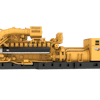
In November 2023, Chevron Products Company, a division of Chevron, U.S.A. Inc., announced plans to transition its Delo Heavy Duty Engine Oil (HDEO) product line into a simplified line of synthetic blends and full synthetic products.
The move came after the company began facing supply chain challenges amidst the pandemic. While components used as building blocks for lubricants were harder to come by, the company found an opportunity to reflect on its portfolio and focus on products that could best serve its customers.
"We found synthetics and synthetic blends to be best aligned with what customers are demanding," said Shawn Whitacre, principal engineer for Chevron. "Those are things like better efficiency, longer oil change intervals, better oil consumption characteristics, lower emissions, and lower viscosities.”
Chevron hasn’t been the only lubricant manufacturer prioritizing synthetics and synthetic blends in recent years. More and more original equipment manufacturers (OEMs) are requiring synthetics for heavy-duty equipment, as synthetics can keep pace with advancing engine technology and a wider range of operating environments better than conventional lubricants.
This is by design. While conventional lubricants are made with standard mineral base oils, synthetic lubricants are made with artificially synthesized base oils. Synthetic blends are made from a blend of both synthetic and mineral-based oils.
“Synthetic base oils are produced in a variety of ways and often in the same types of refineries as conventional base oils, but they're more highly processed,” said Whitacre. “So, they've got characteristics that lend themselves more favorably to the demands of today's products.”
Synthetic Lubricant Benefits
What are the qualities of synthetics that make them so popular? Construction and maintenance service contractors can expect the following benefits from most full synthetics and synthetic blends.
A Robust Response to Temperature
One of the most significant qualities of a lubricant is its response to temperature. This is especially key for engine oils, which can be impacted by both the climate outside the equipment and the environment inside the engine.
"We're looking for characteristics like improved thermal stability, which can certainly be enhanced through the use of synthetic base oils, but also good viscosity index," said Whitacre.
A high viscosity index is one of the defining features of synthetic base oils, which makes synthetics and synthetic blends uniquely suited for a wider range of operating temperatures.
Increased Protection & Resiliency
Synthetic lubricants can provide greater protection against equipment wear and tear. The lubricant leaves a thin coated layer of oil on the equipment, reducing friction and the amount of work needed for parts to move.
“Heavy-duty equipment is designed to be rugged and used in extreme conditions. As such, the lubricants should be able to withstand these conditions and still perform their regular functions,” said Sanya Mathura, managing director of Strategic Reliability Solutions. “Mineral oils have lower tolerances compared to synthetic oils, which may cause the equipment to break down during an important job.”
This protective quality can extend equipment lifespan.
“If you're using a mineral oil, the gears of your machine will be grinding down constantly. You may have to replace that in five years or so, whereas with synthetic, you may have to replace it in about ten years,” said Mathura.
Extended Oil Life
Synthetics and synthetic blends can offer a longer oil drain interval (ODI) than conventional oils. In many cases, major OEMs will recommend engine ODIs at 500 hours or as high as 1,000 hours, when synthetics are used, rather than the traditional standard maintenance interval of 250 hours.
This can be encouraging to consumers who are concerned about the cost of synthetic oils.
"While there is a larger initial cost to purchase synthetic oils, their value greatly benefits the customer in the long run,” said Mathura. “By doubling the ODI, an equipment owner in the construction industry can potentially save thousands of dollars at the end of [the] year.”
Increased Fuel Efficiency
Some synthetics may improve fuel efficiency, which can result in significant savings for firms using the lubricants in multiple machines. This benefit is typically due to the additives that are blended with the synthetic base oils, rather than being a quality inherent to synthetics.
"Improved fuel efficiency is not limited to synthetic oils, but synthetics started introducing it with the development of a 0w16 engine oil," said Mathura. "They have led the way in the drive towards fuel efficiency."
Lower Emissions
According to Whitacre, synthetic lubricants’ response to temperature also makes it a more sustainable option. Conventional lubricants can be more volatile and evaporate more readily than synthetic lubricants, especially when exposed to heat. Synthetic lubricants’ improved thermal stability means they will release fewer emissions overall.
Additionally, synthetic lubricants emit fewer greenhouse gases.
“When you go to synthetics’ thinner base oils, you improve the efficiency of the engine itself, so the engine has to do less work to push that engine oil around,” Whitacre said. “It inherently burns less fuel and emits less carbon dioxide and some of the other greenhouse gasses associated with internal combustion engines.”
Are Synthetics Right for You?
There are a variety of factors to consider when faced with a choice between a fully synthetic, synthetic blend, or conventional lubricant.
For starters, it’s helpful to have a proper understanding of synthetic blends, which are also referred to as semi-synthetics. While synthetic blends are made with a combination of synthetic and mineral base oils, the percentage of each can vary.
“‘Semi’ usually alludes to the fact that it's half, but that may not be the case for each synthetic blend,” said Mathura. “Even if a manufacturer has one percent of synthetic in the base oil, they could get away with calling it a synthetic blend.”
While synthetic blends may have some properties of fully synthetic lubricants, it can be hard to know just how much synthetic oil is in the product. Fortunately, consumers have several criteria to evaluate when determining the ideal lubricant to use—whether full synthetic, synthetic blend, or conventional.
- OEM specifications – First and foremost, ask for your OEM’s guidelines on the proper lubricant for your machine. For those in North America, guidance on engine oils will start with compliance with the performance specifications outlined by the American Petroleum Institute. Your OEM may require a specific lubricant or recommend a range of lubricants from multiple suppliers.
- Viscosity grade – OEMs will typically recommend a range of ambient operating temperatures appropriate for your machine, which will give you a selection of viscosity grades to choose from, according to Karin Haumann, OEM technical services manager at Shell Lubricants. This is where synthetic lubricants, which offer a high viscosity index, can be an asset.
“These synthetic oils are really great in extreme temperature situations,” said Haumann. “For example, if you're in Canada and it's extremely cold, you've got the superior low temperature pumpability and protection at startup. If you're in a desert climate in Arizona with really high temperatures, it prevents the oil from getting too thin.”
- Compatibility – If you’re switching to a new lubricant, you’ll want to ensure the lubricant you choose is compatible with the fluids you currently have left in your machine, said Mathura. Incompatibility issues can cause problems, which “can lead into downtime for your equipment, which nobody wants.”
The Cost of Synthetics
You can’t make a purchase decision without factoring in cost. When selecting a lubricant for your equipment, Whitacre, Mathura, and Haumann all stressed the importance of conducting a cost-benefit analysis.
“Especially in the heavy-duty engine oil world, a large majority of our customers are running a business,” said Whitacre. “Their primary objective is to make money or save money. Oftentimes oil selection plays into that second part of the equation more than anything else.”
While synthetic lubricants may often have a higher initial purchase price, their potential to help reduce expenses could make the investment worthwhile. Whitacre suggested three criteria to help evaluate the financial impact of lubricants.
- The lubricant’s ability to improve durability – The cost of equipment, maintenance, and replacement parts adds up, which means the longer equipment remains operational, the more money you can save. “The lubricant can certainly play a role in protecting against wear and keeping the emission control system clean and maintenance requirements low,” said Whitacre.
- Lubricant lifespan – This includes factors like ODIs. Lubricants that can withstand operating conditions over a longer period require less frequent oil changes, which reduces the cost of labor, filters, and downtime needed for maintenance.
- Lubricant efficiency – The lubricant’s ability to affect fuel consumption should also be considered. Whitacre explained, “In today's fuel price environment, anything businesses can do to reduce fuel burn has a significant impact on their overall fuel spend and, of course, their overall operational cost.”
However, the characteristics of the lubricant alone shouldn’t drive your decision. Mathura stressed that buying a synthetic lubricant needs to make sense for the scope of your operation and your equipment.
“If a synthetic can offer fuel efficiency, you will see more of it if you apply it across a fleet compared to just one piece of equipment,” she said. “Ask yourself, ‘How much can this save me? What is the investment upfront? How long will it take to show that impact?’”
The Future of Synthetics
The use of synthetic lubricants is not a new trend. Synthetics and synthetic blends have been used commercially in construction for several decades. However, the global market for synthetic lubricants is projected to grow at a higher rate than conventional lubricants through 2027, according to a 2023 report by MarketsandMarkets.
While this rapid growth can primarily be attributed to construction and maintenance firms in North America and Europe, companies in Africa, Asia, and Latin America may be slower to adopt synthetics.
“We must remember there are pieces of equipment out there which do require mineral oil,” said Mathura. “Depending on the country that you live in, the age of construction equipment may vary. I have seen people with 20- or 30-year-old machines because they've kept them in good condition and can't afford to replace them.”
Haumann anticipates the trend toward synthetics can only continue as technology advances.
“As equipment advances and our manufacturing capabilities for these synthetic base oils improve, they'll become more prevalent in the market,” she added. “And we'll be able to take advantage of those performance benefits.”



















